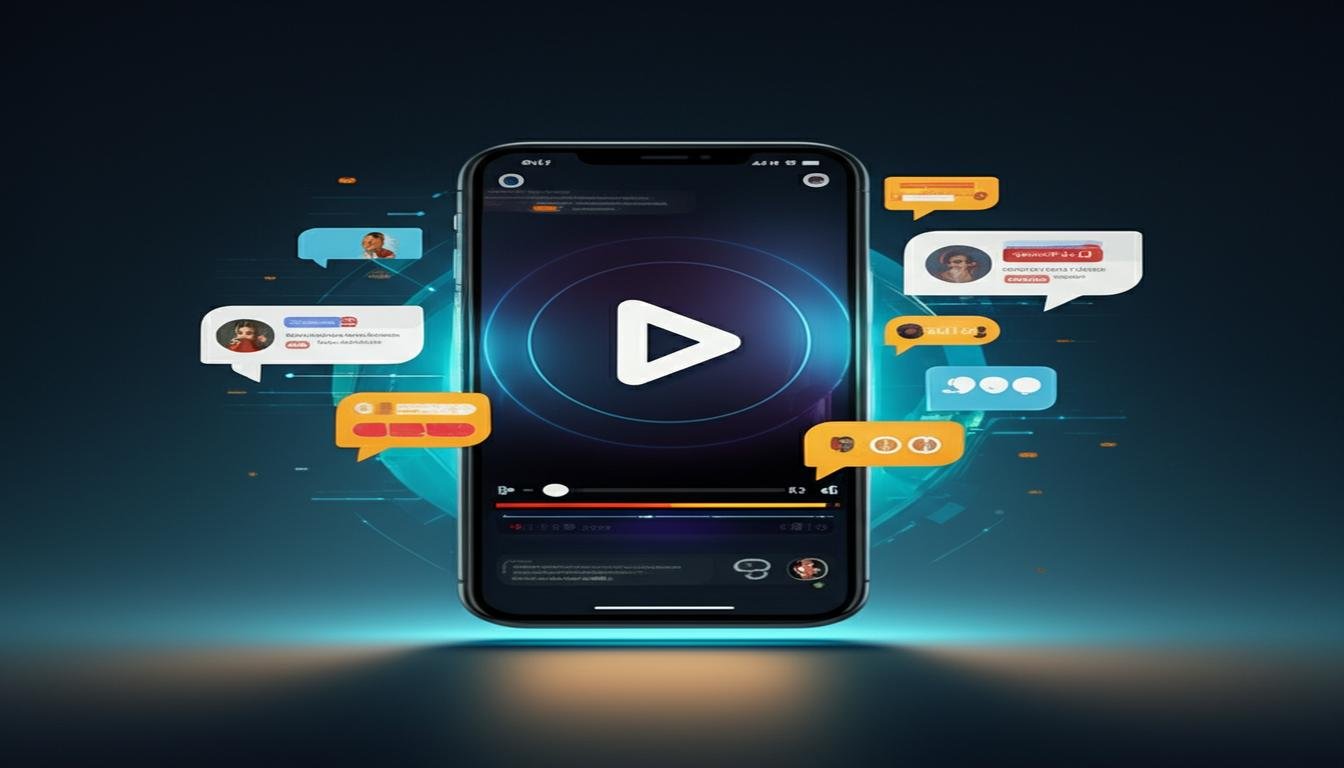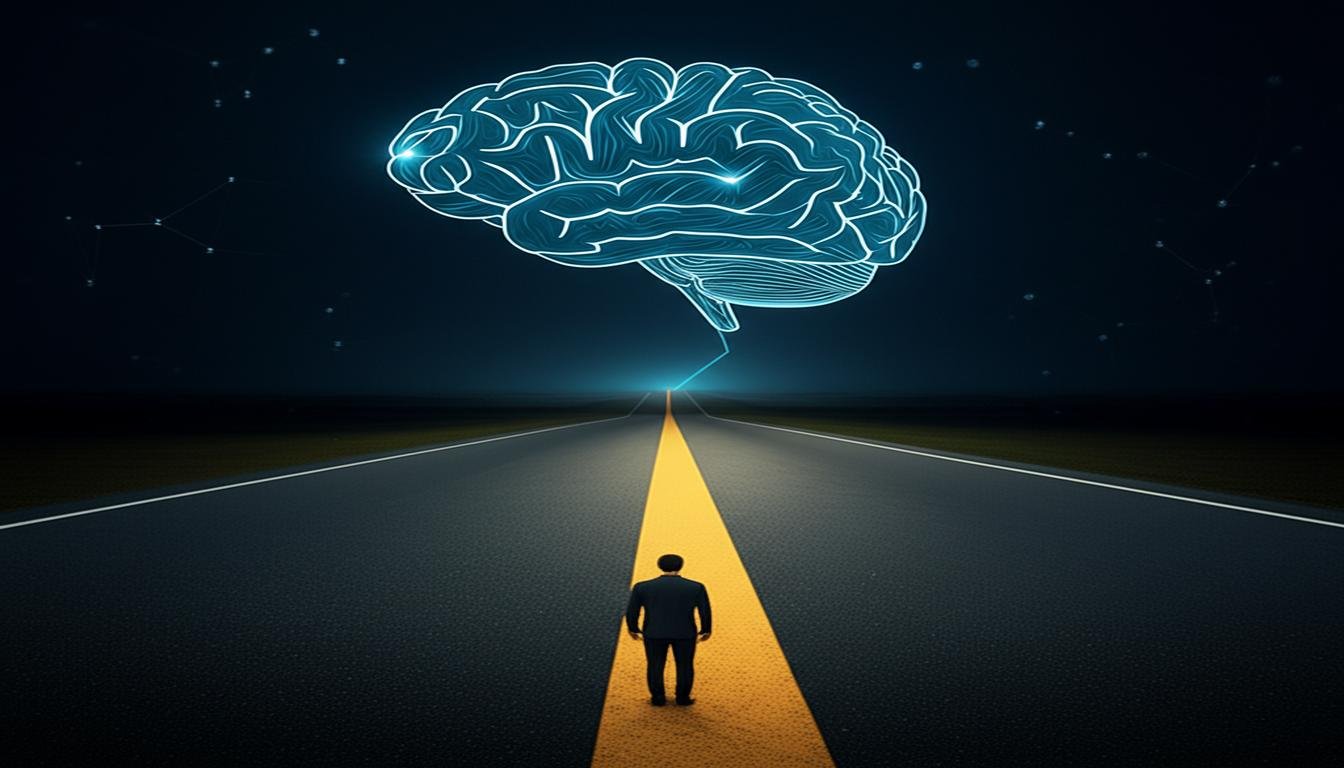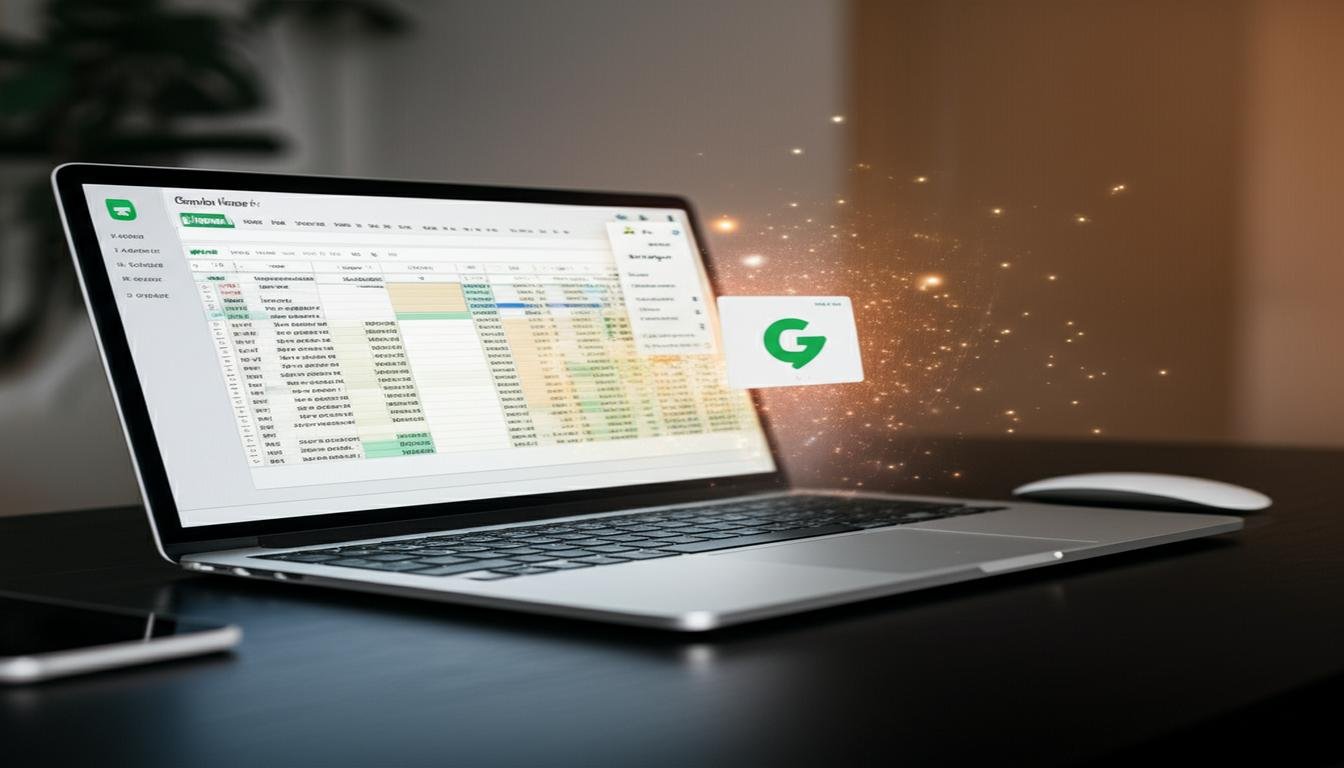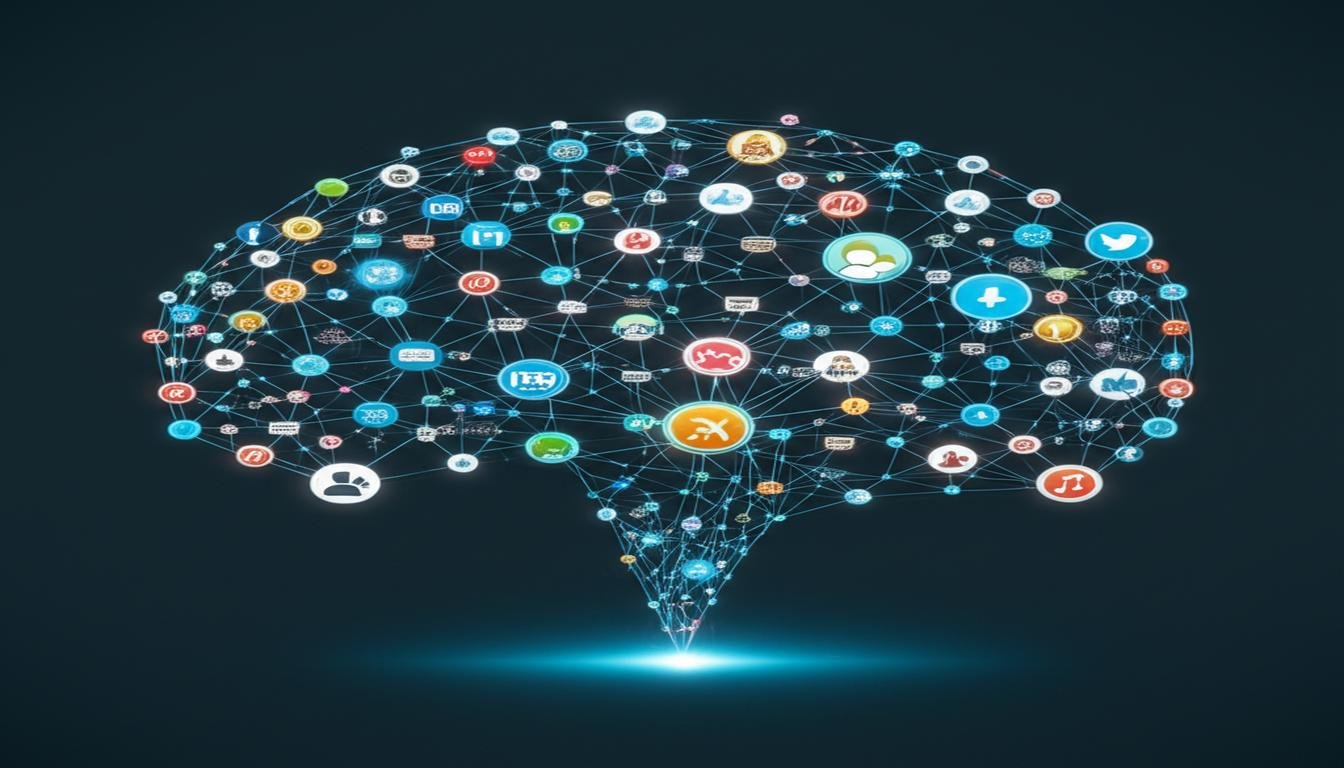Imagine if technology meant to automate tasks could actually strengthen human abilities instead of taking them over. Artificial intelligence is changing many fields, from healthcare to manufacturing. It’s causing both excitement and worry. Let’s get to the heart of it.
Big companies like PwC think AI could lead to 20 million new jobs by 2030. McKinsey believes it could save healthcare systems up to $100 billion a year. These aren’t just dreams—they’re real changes happening now. AI is helping solve big problems, like making education more personal and finding new ways to tackle climate change.
But there are also big questions. How do we make sure AI is used right? Can it really help everyone, not just big tech companies? This article will help you understand the real impact of AI. It shows how we can use AI wisely and why you should be a part of this change.
Table of Contents
Key Takeaways
- AI could generate $100 billion in annual healthcare savings through improved diagnostics and treatment plans
- Emerging roles in AI oversight and data ethics offset automation-related job shifts
- Smart city initiatives reduce energy waste by up to 30% using predictive algorithms
- 84% of businesses report improved decision-making with AI-assisted analytics
- Ethical frameworks are critical to prevent algorithmic bias in hiring and lending systems
Understanding the Impact of AI on Society
Artificial intelligence is changing the game in many areas. It’s not just about new tech; it’s about how we progress as humans. We must ask two key questions: What is modern AI? and How does it benefit us? Let’s dive into these with real examples and results.
Defining Artificial Intelligence in Modern Context
Today, AI ranges from simple tasks to complex systems. Narrow AI, like your email filter, is great at one thing but can’t do much else. On the other hand, strong AI tries to think like us, like self-driving cars.
The true measure of AI lies not in its complexity, but in its capacity to solve human problems at scale.
Framework for Measuring Societal Benefits
We look at AI’s impact in three ways:
- Economic Transformation: PwC says AI could create 7.2 million jobs by 2035
- Healthcare Advancements: IBM Watson makes medical diagnoses 30% faster than humans
- Environmental Progress: AI can cut energy waste by up to 15% in cities
Let’s compare before and after AI:
| Metric | Pre-AI | Post-AI |
|---|---|---|
| Manufacturing Defect Detection | 85% accuracy | 99.5% accuracy |
| Emergency Response Times | 12-minute average | 6-minute average |
These numbers show AI’s real value. It’s not just about tech; it’s about making our lives better. We’ll see how AI helps in healthcare and farming too.
Revolutionizing Healthcare Delivery
Artificial intelligence is changing medicine in big ways. It can spot diseases early and create treatments based on your DNA. These changes are making healthcare safer, faster, and more precise.
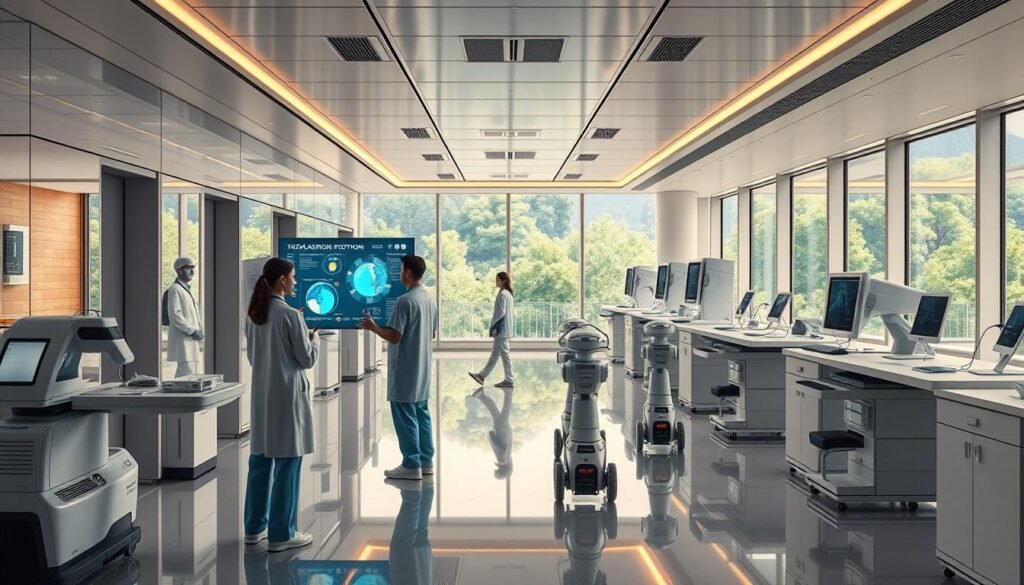
Early Disease Detection Systems
Imagine finding cancer years before it’s usually detected. Google DeepMind’s AI tool does just that, spotting tumors with 39% greater accuracy than doctors. It checks medical images very closely, catching things doctors might miss.
Hospitals like Children’s National Medical Center use AI for surgery. The da Vinci system lets surgeons do complex operations through tiny cuts. This cuts recovery times by up to 50%.
Drug Discovery Acceleration
Finding new medicines doesn’t take decades anymore. BenevolentAI used AI to find COVID-19 treatments in weeks by looking at 3 million papers. AI can predict how molecules work, speeding up drug development from 5 years to 18 months.
Big pharma companies are using AI for:
- Simulating clinical trial results
- Finding treatments for rare diseases
- Finding new uses for existing drugs
Personalized Treatment Plans
Your medical care is getting more personal. IBM Watson looks at your health records and medical journals to suggest treatments. Cancer centers use it to find the right therapy for your tumor.
Nuance’s AI tools update patient records during visits. This saves doctors 45% of their time, letting them focus on you.
Also Read: How Many Jobs Have Been Lost to AI
Transforming Education Systems
Artificial intelligence is changing classrooms and school work in big ways. It tackles old problems by mixing personalized learning with better school management. This makes schools better places for both students and teachers.
Adaptive Learning Platforms
Carnegie Learning’s MATHia shows how AI can change teaching. It checks how students do and changes the lessons to fit each one. Here’s what it has achieved:
- Students learn 27% faster than before
- It finds where students need help
- Students get feedback that keeps them on track
The system lets me focus on mentoring instead of grading. I’ve reclaimed 6 hours weekly for one-on-one sessions.
Automated Administrative Support
Georgia State University’s AI chatbot shows how automation helps schools. It answers 53% of simple questions, leading to:
- 22% fewer students drop out
- Answers to financial aid questions 83% faster
- Less overtime for staff by 17%
This makes schools work better. Schools using similar systems see:
- 38% fewer missed scholarship deadlines
- 15% more parents at parent-teacher conferences
Enhancing Environmental Sustainability
Artificial intelligence is changing how we face climate challenges. It helps predict environmental changes and improve how we use resources. AI offers solutions to cut down energy waste and forecast ecological trends. These innovations are making a real difference.
Climate Modeling Improvements
AI systems now handle huge climate datasets much faster than before. Google’s DeepMind cut down cooling costs in data centers by 40%. It does this by analyzing weather and equipment performance in real-time.
Startups like ClimateAi also use AI to predict how crops will do in changing climates. They help farmers plan planting and irrigation months ahead. For example:
- Predicting drought risks for wheat crops in California
- Optimizing fertilizer use in Midwest cornfields
Smart Energy Management
AI is making renewable energy distribution smarter. Texas wind farms using AutoGrid systems saw an 18% increase in output last year. These systems balance energy supply and demand by analyzing:
| Factor | Traditional Approach | AI-Driven Solution |
|---|---|---|
| Energy Demand Prediction | 24-hour forecasts | Real-time adjustments |
| Grid Maintenance | Scheduled inspections | Predictive analytics |
| Renewable Integration | Manual balancing | Automated load shifting |
Utilities using AI report 22% fewer outages and 15% cost savings each year. Even small towns can use smart meters to cut down on energy waste.
Optimizing Agricultural Production
Artificial intelligence is changing farming, making it more productive and eco-friendly. AI helps farmers use less chemicals and predict harvests. This way, AI supports sustainable food systems and benefits communities.
Precision Farming Techniques
Today, farms use AI to use resources wisely. John Deere’s See & Spray tech spots weeds instantly. This cuts herbicide use by 90% compared to old methods.
Other cool tech includes:
- Taranis’ aerial imaging finds plant stress at tiny levels
- Soil sensors check moisture and nutrients every 15 minutes
- GPS-guided tractors save fuel by taking the best route
USDA pilot programs using these technologies reported 17% higher crop yields while using 23% less water.
Crop Yield Prediction Models
AI algorithms predict harvests with great accuracy. They look at:
- Historical weather patterns
- Satellite vegetation indexes
- Local pest trends
These models help farmers plan the best planting times and crop choices. In 2023’s Midwest drought, AI helped farmers switch to drought-resistant corn. This saved $410 million in losses, reports say.
As these tools get easier to use, they help solve food security issues. Small farms using yield apps saw a 14% profit increase last year. This shows tech can help all farms.
Advancing Transportation Safety
Artificial intelligence is changing how we travel, making roads and cities safer. It helps everyone, from daily drivers to truckers. Let’s look at two big ways AI is making a difference.
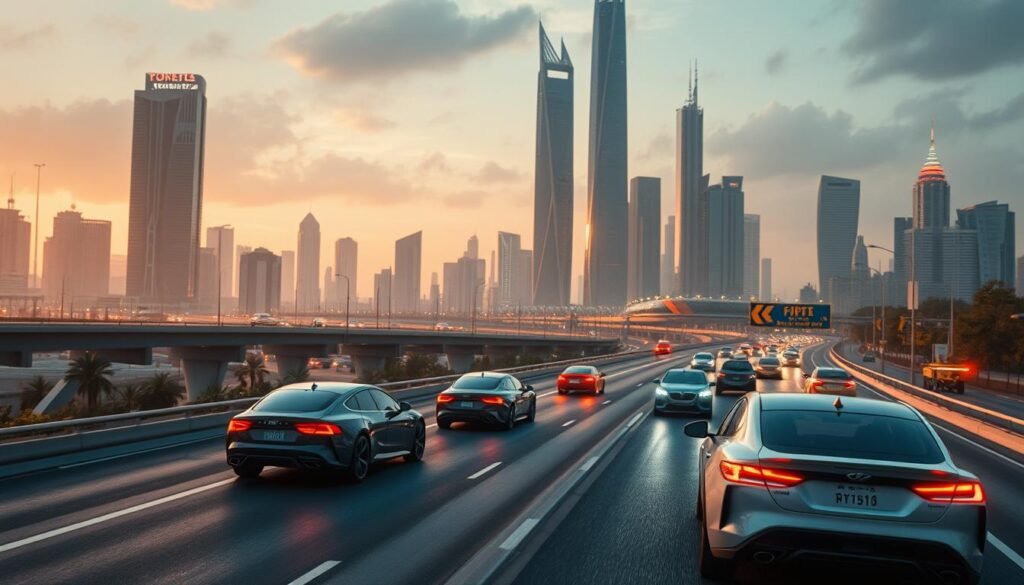
Self-Driving Vehicle Breakthroughs
Waymo’s cars have driven over 10 million miles without accidents. They use advanced AI to:
- Map surroundings with 360-degree LIDAR
- Understand how cyclists and scooters move
- Adjust to weather changes instantly
The National Highway Traffic Safety Administration says AI could cut alcohol-related crashes by 94% by 2040. This shows AI’s power to save lives.
Intelligent Traffic Coordination
In Pittsburgh, AI traffic signals have cut commute times by 26% and emissions by 21%. The system looks at:
- How many cars are moving
- When pedestrians cross
- When emergency vehicles need to go fast
| Feature | Traditional System | AI-Enhanced System |
|---|---|---|
| Response Time | Fixed intervals | Millisecond adjustments |
| Accident Prediction | Reactive alerts | 30-minute advance warnings |
| Fuel Efficiency | 8% idle time | 2% idle time |
AI is making commutes better and safer. It’s used in 47 U.S. cities, showing it works everywhere.
Machine learning in traffic management isn’t just about speed – it’s about creating ripple effects in urban air quality and community accessibility.
Empowering Financial Inclusion
Artificial intelligence is changing how people get access to money. In 2021, over 7 million U.S. homes didn’t have bank accounts. But AI is making it easier for people to join the economy. It helps with fair credit checks and keeps money safe.
AI-Driven Credit Scoring
Old credit systems often leave out those without a banking history. Tala uses phone data to judge if someone can get a loan. This has helped over 5 million people get loans, showing AI can find new ways to see if someone is reliable.
Fraud Detection Systems
Many are scared to use digital money because of security worries. Mastercard’s AI checks transactions fast, cutting down on false blocks by 60%. This means more real payments get through, helping small businesses.
| Financial Service | Traditional Approach | AI-Driven Solution | Impact |
|---|---|---|---|
| Credit Scoring | Credit bureau reports | Behavioral analytics | +42% approval rates |
| Fraud Prevention | Rule-based alerts | Pattern recognition | 60% fewer false blocks |
| Account Security | Password protection | Biometric verification | 89% faster authentication |
These changes show how AI and society work together to make things fairer. By using data wisely and with care, banks can help more people. AI is not just about tech; it’s about opening up new chances for everyone.
Strengthening Disaster Response
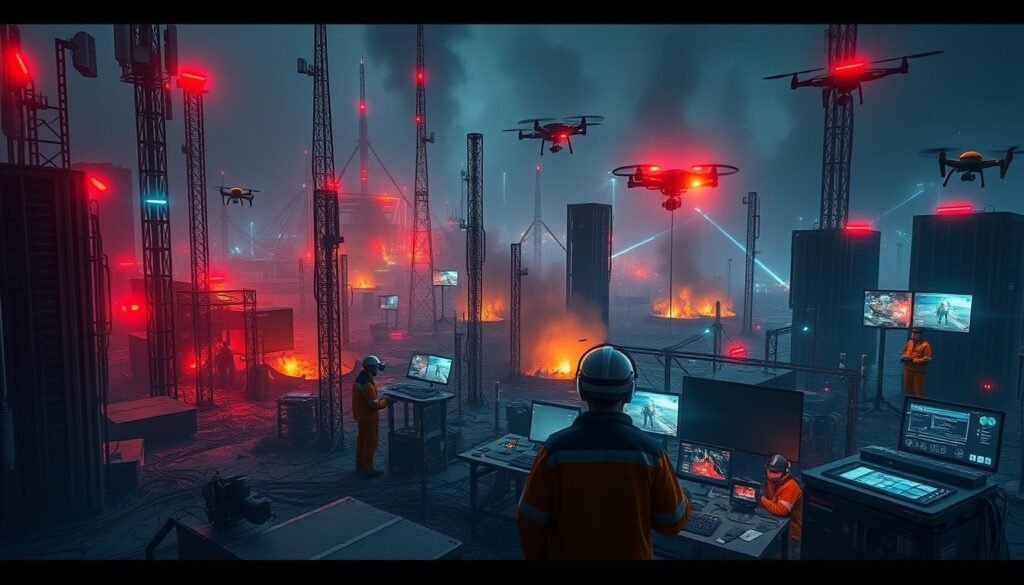
When hurricanes flood cities or wildfires spread uncontrollably, artificial intelligence steps in. It acts as a silent guardian. Modern disaster management now uses machine learning tools.
These tools predict calamities before they happen. They also speed up life-saving actions when every second matters.
Predicting the Unpredictable
Companies like One Concern use AI to analyze 1.2 million data points. This includes soil moisture levels and urban infrastructure maps. They achieve 94% accuracy in flood predictions.
During Hurricane Ian, FEMA used these systems to:
- Evacuate 12,000 residents 48 hours before landfall
- Redirect emergency supplies to high-risk zones
- Prioritize rescue teams based on real-time damage assessments
AI models helped us reduce response times by 37% compared to previous disasters, said a FEMA operations director. We’re not just reacting – we’re staying three steps ahead.
Robots to the Rescue
When traditional methods fail, AI-powered drones take over. Zipline’s delivery networks in disaster zones show how AI impacts survival:
| Metric | Human Teams | AI Drones |
|---|---|---|
| Medical Delivery Time | 6.5 hours | 22 minutes |
| Success Rate | 68% | 94% |
| Cost per Mission | $480 | $110 |
These systems use computer vision to navigate through smoke-filled skies. They deliver emergency supplies to precise GPS coordinates. During California’s wildfire season, drones found 83% more survivors than human spotters alone.
The ai influence on society is most evident during disasters. From predictive flood models to autonomous rescue drones, these technologies change how we protect vulnerable communities. They show that artificial intelligence affects our daily lives most profoundly during our darkest hours.
Boosting Manufacturing Efficiency
Artificial intelligence is changing factory floors around the world. It brings big improvements that set new standards for production. Aspects of artificial intelligence tackle problems like downtime, waste, and mistakes.
Predictive Maintenance Solutions
Equipment failures cost factories $50 billion each year. But AI systems help cut these losses. GE Aviation, for example, lowered energy use by 15% with sensors that check turbine performance live.
These tools:
- Watch for changes in vibration and temperature
- Spot wear in parts 3-6 weeks early
- Plan repairs when it’s quiet
One car factory saw unplanned downtime drop by 40% with these self-learning maintenance algorithms. A manager said:
Our machines now tell us when they need care, not the other way around.
Quality Control Automation
Siemens’ AI vision systems catch defects with 99.98% accuracy in electronics. They:
- Check 5,000 units every minute without getting tired
- Find tiny flaws that humans can’t see
- Keep up with new product designs
This method cut false rejects by 75% at a German chip factory. The tech gets better with each mistake, showing how what artificial intelligence can do today in making things.
With real-time production tweaks, these changes show AI does more than just automate. It’s changing how we make things better.
Improving Workplace Productivity
Artificial intelligence is changing how we work. It offers tools that make tasks easier and help us make better decisions. Current AI solutions automate routine tasks and analyze big data. This lets teams focus on important work and cut down on mistakes. Let’s look at two big changes happening in offices today.

Intelligent Process Automation
UiPath shows how robotic process automation (RPA) cuts down on delays. Their examples show 70% faster processing times for things like invoices and new employee onboarding. These AI bots handle:
- Data entry across multiple platforms
- Document classification and routing
- Compliance checks using natural language processing
One logistics company went from 45 minutes to 12 seconds for shipments. This lets staff focus on helping customers and planning, not just paperwork.
Enhanced Decision Support Systems
Deloitte’s AI tools for auditing show how machine learning boosts accuracy in financial checks. Their system finds issues 83% faster than old methods and gets better with feedback. Microsoft Viva Insights does even more by:
- Analyzing meeting patterns to prevent burnout
- Suggesting optimal focus time blocks
- Identifying collaboration gaps between departments
A tech company cut down on meetings by 34% and finished projects faster. This mix of human skills and AI makes smarter workflows that meet company needs.
These changes show how AI makes our work lives better. As AI tools get better, they’ll find new ways to make work more efficient and better for employees.
Democratizing Access to Legal Services
Artificial intelligence is changing how we deal with legal matters. It makes complex legal processes easier and more affordable. Now, AI offers instant, affordable support for things like contract reviews and dispute resolutions.
Contract Analysis Tools
Legal teams use tools like LawGeex to show AI’s power in reviewing documents. It spots errors in contracts with 95% accuracy, just like humans but 80% faster. The benefits are clear:
- Real-time red flag detection
- Standardized compliance checks
- Multi-language support
AI contract review eliminates the bottleneck of manual analysis without sacrificing quality, notes a 2023 American Bar Association report.
Public Legal Assistance Bots
Services like DoNotPay are making a big difference. They’ve helped solve over 2 million cases, from parking tickets to small claims. These chatbots make legal language easier to understand by:
- Step-by-step form completion
- Jurisdiction-specific regulation updates
- 24/7 accessibility via mobile devices
The ABA says there’s been a 40% increase in people using AI for legal help. This is true for housing and family law issues.
These technologies are not replacing lawyers but opening up new ways for people to get legal help. From startups to tenants fighting unfair evictions, AI is making a big difference. It’s making legal services more efficient and accessible to more people.
Enhancing Personal Daily Life
Artificial intelligence is now a big part of our daily lives. It helps us wake up and relax. Over 64% of U.S. households use smart devices, showing how AI is everywhere. It changes how we live, work, and play.
Smart Home Integration
Voice-activated assistants and smart thermostats like Nest show AI’s value. They learn our habits to automatically adjust things like temperature and lights. Nest says users save 15% on energy bills each year.
Benefits include:
- Control of appliances with smartphone apps
- Alerts for HVAC system maintenance
- Security cameras that know the difference between pets and intruders
Personalized Health Monitoring
Wearables like Fitbit use AI to improve health. They detect heart issues with 98% accuracy. This helps users get medical help early.
Health tools now offer:
- Scoring of sleep quality
- Reminders to drink water based on activity
- Tracking of medication with smart pillboxes
AI in Consumer Entertainment
Streaming services like Netflix show AI’s creativity. They spend $1 billion yearly on their recommendation engine. It looks at 250+ factors for each user. This leads to 80% of content being AI-recommended.
Entertainment innovations include:
- Music apps that match your workout
- Smart TVs adjust brightness based on room light
- AR games that adjust to your skill level
These changes show AI’s role in making our lives better. It does this in a way that feels natural and helpful.
Conclusion
AI has made big changes in society, like helping find cancer early with IBM Watson Health. It also keeps cars safe with Tesla Autopilot. These examples show how AI and society can work well together.
AI helps in many ways, like saving water in farming and making legal advice easier. It brings real benefits to different areas.
But, there are challenges too. For example, AI can sometimes be unfair or change jobs. Companies like Microsoft and LinkedIn are working on these problems.
They use tools and rules to make sure AI is used right. This helps everyone.
You can help shape AI’s future. If you work in tech, you can push for clear AI models. If you’re new, you can learn about AI ethics for free.
Together, we can make AI tools that help us, not just replace us.
AI is changing education and energy, for better. But we need to make sure everyone has access. We must work together.
Developers, policymakers, and citizens all have a role. We need to understand and use AI wisely.
What will you do today to help AI and society grow together? Every action counts. Whether it’s trying new AI tools or talking about its impact, we’re all in this together.
FAQ
How is AI creating new job opportunities while displacing others?
AI is changing jobs, but it’s also creating new ones. PwC says we’ll see 7.2 million new jobs by 2030. Companies like IBM and Google are helping workers learn new skills for these jobs.
Can AI systems truly improve healthcare outcomes better than human doctors?
In some cases, yes. Google DeepMind’s AI is 39% better at finding breast cancer than doctors. But AI works best when it works with humans. For example, the da Vinci system helps surgeons, making surgeries safer.
What measurable environmental benefits does AI provide?
AI can help the environment a lot. Google cut its cooling costs by 40% with AI. ClimateAi helps farmers, saving 18% of crops in California.
How does AI address financial inclusion for unbanked populations?
Companies like Tala use new ways to check credit. Mastercard’s AI cuts down on false fraud alerts, saving billions of dollars.
Are autonomous vehicles actually safer than human drivers?
Yes, they are. Waymo’s cars have driven millions of miles without accidents. NHTSA says AVs could prevent 94% of crashes caused by drunk drivers.
How does AI personalize education effectively?
AI can make learning better for everyone. Carnegie Learning’s MATHia adapts to students, helping them learn faster. Georgia State’s chatbot helps students stay in school, reducing dropout rates by 22%.
What safeguards exist against AI bias in critical systems?
IBM’s AI Fairness 360 checks algorithms for bias. The EU AI Act requires bias testing in important systems. Siemens uses AI to find and fix defects, reducing errors by 75%.
How does AI accelerate legal access for average citizens?
AI can make legal help more affordable. DoNotPay’s AI helps with parking tickets and small claims. LawGeex reviews contracts fast and accurately, making legal advice more accessible.
Can smart home AI truly reduce energy costs?
Yes, it can. Nest’s thermostat saves 15% on heating and cooling. Smart devices in 64% of US homes help reduce energy use during peak times.
How reliable are AI disaster prediction systems?
AI can predict disasters well. One Concern’s models are 94% accurate 5 days before a flood. FEMA used AI to speed up disaster relief after Hurricane Ian.










